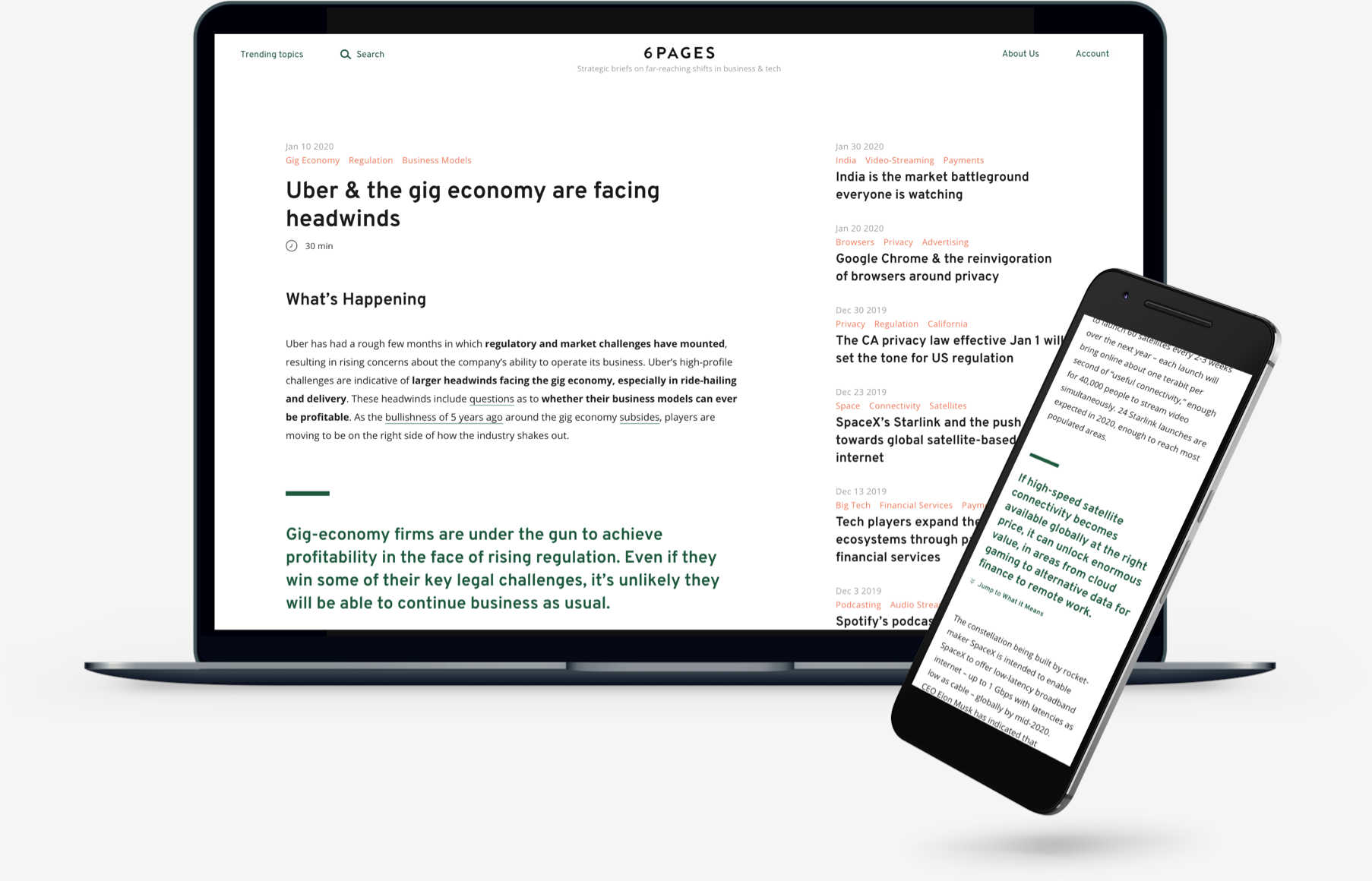“
6Pages write-ups are some of the most comprehensive and insightful I’ve come across – they lay out a path to the future that businesses need to pay attention to.
— Head of Deloitte Pixel
“
At 500 Startups, we’ve found 6Pages briefs to be super helpful in staying smart on a wide range of key issues and shaping discussions with founders and partners.
— Thomas Jeng, Director of Innovation & Partnerships, 500 Startups
“
6Pages is a fantastic source for quickly gaining a deep understanding of a topic. I use their briefs for driving conversations with industry players.
— Associate Investment Director, Cambridge Associates
Read by

Used at top MBA programs including
Apr 25 2025
11 min read
1. Restarting student loan collections
- This past Monday, the US Dept of Education under the Trump administration announced it would begin resuming collections on defaulted federal student loans, starting on May 5. This represents a policy reversal, since the Education Dept (ED) has not collected on student loans in default since Mar 2020 (when it was paused under the first Trump administration). Now, in just a little over 2 weeks, borrowers in default will again be subject to enforcement mechanisms to recoup their debt.
- Collections are typically enforced through the Treasury Offset Program (TOP). TOP has the power to withhold federal payments and some state payments – including tax refunds (100%) and Social Security benefits (15%) – and apply them toward defaulted debt, with 60-65 days’ notice.
- The ED can also initiate administrative wage garnishment, ordering employers to seize 15% of a borrower’s “disposable pay” (after deductions) without a court order. The ED plans to begin sending out the required notices for garnishment “later this summer,” and can begin garnishing wages 30 days thereafter. The garnishments then continue until the full debt is paid or the loan is out of default.
- Unlike most debts, federal student loans have no statute of limitations on collections, meaning the government can pursue borrowers indefinitely. Federal student loan debt is still very difficult to discharge through bankruptcy, since borrowers must show “undue hardship.” Just 588 bankruptcy cases were filed from Oct 2023-Mar 2024, for instance, despite the more streamlined process under the Biden administration. (98% of the cases filed, however, received at least a partial discharge.)
- According to the ED’s definition, borrowers are technically in default if they have not made a payment in 270+ days. Going into default triggers the entire balance coming immediately due, being reported to credit agencies as being in default (after 65 days’ notice), and now collections, among other serious consequences. At the 360-day mark, borrowers become ineligible for income-driven repayment (IDR) plans and the ED’s collection activities begin to escalate.
- Estimating the borrowers in default is somewhat complicated by the various programs extended under the Biden administration in support of borrowers. First, a series of extensions on the Mar 2020 pause meant student loans were on pause for 3.5 years – starting in Oct 2023. After broad forgiveness was struck down by the Supreme Court, the Biden administration moved to forgive loans for targeted groups (e.g. public-service workers under the Public Service Loan Forgiveness program, permanently disabled borrowers, defrauded borrowers, borrowers with sufficient payments under IDR plans). In total, the Biden administration forgave $189B in loans to 5.3M borrowers over the term. Other borrowers took advantage of Biden-era programs such as the Fresh Start program that returned defaulted borrowers that opted in to good standing, and a SAVE (Saving on a Valuable Education) IDR plan that brought payments down to zero for some.
- Importantly, around the time when repayments restarted in late 2023, Biden’s ED implemented a 12-month “on-ramp” period (Oct 1 2023-Sep 30 2024), during which missed payments would not immediately trigger default or harm credit. Loans would still accrue interest during this period, but were held from moving into later-stage delinquency buckets. As of the end of the on-ramp period, an estimated 20% of borrowers had still not made any payments, according to one survey. Today represents the 207-day mark after the on-ramp period’s end, and the 270-day mark would be Jun 27 2025.
- Of the 42.7M borrowers (representing $1.6T in federal student loans), only 38% (16M borrowers) are current and in repayment on their loans. 5.6M borrowers were already considered in default as of end of 2024 (after the on-ramp period), 5.3M borrowers are currently in default, and 5M+ have not made a payment in 360+ days. Another 4M borrowers are in “late-stage delinquency” (91-180 days), with negative credit reporting already begun. (These borrowers entered delinquency after the on-ramp period.) In total, nearly 10M borrowers in total – just under 25% of the federal student-loan portfolio – could be in default within 3 months. Another 5.6M borrowers are 61-90 days delinquent.
- Some of the remaining borrowers are in an interest-free forbearance or deferment, or are in school or in the subsequent 6-month grace period. Among these are borrowers who were put into limbo in Aug 2024 when a federal appeals court blocked the Biden administration’s income-driven repayment plan (SAVE). 8M SAVE borrowers were put into interest-free forbearance at that time, and processing has been on hold for almost 1.9M IDR applications. The Trump administration plans to restart processing IDR applications next month.
- Borrowers in default can engage in loan rehabilitation (9 monthly payments), loan consolidation, or repayment in full. The Public Service Loan Forgiveness program is still available, although Trump’s recent executive order strips eligibility from employees of organizations engaged in “illegal activities” – such as aiding illegal immigration or discrimination.
- The changes over the past 5 years present complications after such a long hiatus. Borrowers are often returning to repayment under new payment schedules and sometimes new loan servicers. The average student-loan borrower owes $38K and has a $536 monthly payment. Many have yet to make a single payment. A student-loan delinquency can drop credit scores by 100 points or more, seriously impacting consumers’ ability to be approved for a mortgage or other loan, or rent a home. This will aggravate the financial stress for borrowers already under pressure from recent tumultuous markets, as projections of recession rise to 40-90%.
Related Content:
- Sep 1 2023 (3 Shifts): US student-loan payments are coming back and what it will mean
- Apr 11 2025 (3 Shifts): The tariff rollercoaster and China
Become an All-Access Member to read the full brief here
All-Access Members get unlimited access to the full 6Pages Repository of763 market shifts.
Become a Member
Already a Member?Log In
Disclosure: Contributors have financial interests in Meta, Alphabet, and OpenAI. Amazon, Google, and OpenAI are vendors of 6Pages.
Have a comment about this brief or a topic you'd like to see us cover? Send us a note at tips@6pages.com.
All Briefs
Get unlimited access to all our briefs.
Make better and faster decisions with context on far-reaching shifts.
Become a Member
Already a Member?Log In
Get unlimited access to all our briefs.
Make better and faster decisions with context on what’s changing now.
Become a Member
Already a Member?Log In


